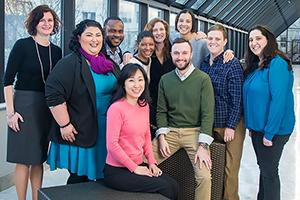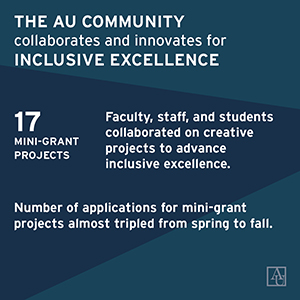On Campus
American University’s Plan for Inclusive Excellence: The First Year

One year ago, American University announced its Plan for Inclusive Excellence. A comprehensive blueprint for building a truly inclusive community, the plan signifies the university’s commitment to increasing and supporting diversity, equity, and inclusion on campus and beyond.
This inaugural year represents a point on a longer journey toward an inclusive culture. Change takes many hands and ongoing, intentional action. The first year has focused on making structural, systemic, and cultural changes to lay the foundation for the future, and progress has been made under each of the five goals of the plan. While AU has taken notable steps in its goals, the one-year update includes areas for improvement or expansion and next steps toward strengthening the community.
“We’re calling these promising signs for a reason,” said President Sylvia M. Burwell, in a letter to the community. “They’re not guarantees, nor are any of them alone going to bring about inclusive excellence at American University. They’re indicators of progress and a sign to keep working.”
As the university moves into year two of the plan, learn more about the progress thus far, and the ways in which this community can continue to grow, learn, and embody its values of inclusion and free expression. While some progress has been made under each of the plan goals, much of the effort in year one has intensely focused on goals 1 and 2, with the belief that these goals are foundational to the success of all goals of the plan.
Goal 1: Training, Learning, and Development
In the first year AU enhanced training, learning, and development opportunities available to faculty, staff, students, and university leadership—from the top down. Using the Intercultural Development Inventory tool, which assesses and builds organizational cultural competence, 100 percent of the cabinet, PCDI members, and the 21st Century Leadership Institute—a development program for mid-level staff that integrates experiential and cognitive learning with practical action—received training.
Additionally, newly trained faculty trainers led 500 faculty colleagues across campus in building inclusive teaching practices. In the fall of 2018, more than 450 faculty and staff participated in inclusive excellence trainings, and 77 percent reported that they learned something they will use to make their work more inclusive. On the student side, 89 percent of incoming first-year students at Eagle Summit participated in an intercultural engagement session in the summer of 2018.
Goal 2: Campus Climate, Culture, and Community
The second goal of the plan is focused on fostering a campus climate where all community members feel safe and have a sense of belonging and satisfaction.
In the spring of 2018, the university launched the first round of inclusive excellence mini-grants, which offer all members of the AU community, including faculty, staff, students, and alumni, the opportunity to contribute to inclusive excellence on campus.
 “Part of changing the culture is we have to change how we do what we do every day. We’re working in new ways to incubate those collaborative structures,” said Amanda Taylor, assistant vice president of diversity, equity, and inclusion, citing the mini-grants as an example.
“Part of changing the culture is we have to change how we do what we do every day. We’re working in new ways to incubate those collaborative structures,” said Amanda Taylor, assistant vice president of diversity, equity, and inclusion, citing the mini-grants as an example.
In April of 2019, a symposium supported by one of the inclusive excellence mini-grants will aim to help participants understand disability and accessibility as key dimensions of diversity and inclusion.
“Access means so much more than just an added ramp. Thinking about access means thinking about all the different ways in which we are human,” said Tanja Aho, visiting assistant professor of American studies and co-recipient of the mini-grant. “It means creating an environment that is inclusive because inclusive environments are better for everyone.”
In fall 2018, 69 percent of first-year students indicated an initial sense of belonging at AU, a six percent increase over fall 2017. Though there was little variation by race or ethnicity, the data does show incoming first-year students with disabilities are slightly more concerned than peers about not being welcomed, highlighting an area for growth.
What’s next?
“In year one, we have some initial encouraging pieces,” Aw said. “This is hard work, and it’s necessary work. As a learning organization, we recognize that there’s more work to do, and we have learned things along the way that will inform our work going forward.”
Among the next steps, according to Aw and Taylor, are developing a holistic evaluation tool for measuring success; deepening the focus on research; administering a staff and faculty campus climate survey in spring 2019; enhancing accessibility campus wide; broadening student engagement with the plan; and engaging with the community to build out years three to five of the plan.
There remains very important work to be done to continue to build students’ sense of belonging on campus, and to increase recruitment and retention of historically underrepresented faculty, staff, and students campus-wide. Moving forward, AU will deepen efforts to enhance and broaden faculty engagement in learning for inclusive teaching and mentoring, as well as continue to focus on increasing student scholarship support and staff professional development.
“We’re just at the beginning,” Aw said. “We’re committed to this journey, we have seen some promising practices, and the momentum is building.”